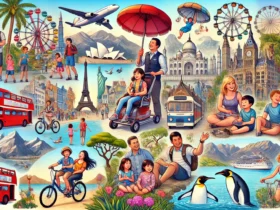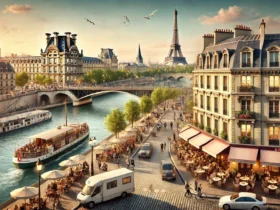Bangkok, the vibrant capital of Thailand, is a city that seamlessly blends the old with the new. With its bustling markets, serene temples, and electrifying nightlife, Bangkok offers something for every traveler. If you’re planning a trip to this dynamic city, here’s a curated itinerary to help you make the most of your visit.
Day 1: Exploring the Heart of Bangkok
Morning: Grand Palace and Wat Phra Kaew Start your journey at the Grand Palace, a must-see landmark. This sprawling complex served as the royal residence for generations and is home to Wat Phra Kaew, the Temple of the Emerald Buddha. The intricate architecture and detailed murals are truly awe-inspiring.
Afternoon: Wat Pho and Reclining Buddha Just a short walk from the Grand Palace, you’ll find Wat Pho, known for the massive Reclining Buddha statue. Take some time to explore the temple grounds and perhaps enjoy a traditional Thai massage at the temple’s massage school.
Evening: Chao Phraya River Dinner Cruise End your day with a relaxing dinner cruise along the Chao Phraya River. Enjoy delicious Thai cuisine while taking in the illuminated cityscape, including views of iconic landmarks such as Wat Arun.
Day 2: Culture and Cuisine
Morning: Jim Thompson House Begin your day with a visit to the Jim Thompson House, the former home of the American businessman and silk entrepreneur. The house is now a museum showcasing Thai art and antiques.
Afternoon: Chatuchak Weekend Market If your visit falls on a weekend, don’t miss the Chatuchak Weekend Market, one of the largest markets in the world. Here, you can find everything from clothing and accessories to home decor and street food.
Evening: Street Food Tour Bangkok is famous for its street food. Join a guided street food tour or explore on your own in areas like Yaowarat (Chinatown) or Khao San Road. Sample local delicacies such as pad thai, mango sticky rice, and spicy papaya salad.
Day 3: Modern Bangkok
Morning: Bangkok Art and Culture Centre (BACC) Spend your morning at the Bangkok Art and Culture Centre, which hosts contemporary art exhibitions, performances, and cultural events. It’s a great place to get a feel for the modern art scene in Bangkok.
Afternoon: Shopping at Siam Paragon and MBK Center Bangkok is a shopper’s paradise. Head to Siam Paragon for luxury brands and high-end shopping, then cross the street to MBK Center for more affordable options and a diverse range of goods.
Evening: Rooftop Bar Experience End your trip with a visit to one of Bangkok’s famous rooftop bars. Enjoy panoramic views of the city skyline from spots like Sky Bar at Lebua State Tower or Vertigo and Moon Bar at Banyan Tree Hotel.
Additional Tips
- Transportation: Use the BTS Skytrain or MRT subway to navigate the city efficiently. Tuk-tuks and taxis are also readily available.
- Dress Code: When visiting temples, dress modestly. Shoulders and knees should be covered.
- Safety: Bangkok is generally safe, but always stay aware of your surroundings and keep your belongings secure.
Conclusion
Bangkok is a city of contrasts and surprises, offering a rich tapestry of experiences for travelers. Whether you’re drawn to its historic temples, bustling markets, or modern attractions, this itinerary will help you uncover the best of what Bangkok has to offer. Enjoy your trip
Frequently Asked Questions (FAQ) about Traveling to Bangkok
1. When is the best time to visit Bangkok?
The best time to visit Bangkok is during the cool season, from November to February, when the weather is more comfortable with lower humidity and cooler temperatures. However, this is also the peak tourist season, so expect larger crowds and higher prices.
2. What are the must-see attractions in Bangkok?
Some must-see attractions include the Grand Palace and Wat Phra Kaew, Wat Pho (Temple of the Reclining Buddha), Wat Arun (Temple of Dawn), Jim Thompson House, and the Chatuchak Weekend Market. Don’t forget to explore the vibrant street food scene and visit a rooftop bar for stunning city views.
3. How can I get around Bangkok?
Bangkok has a variety of transportation options:
- BTS Skytrain and MRT Subway: Efficient and air-conditioned, these are the best ways to avoid traffic.
- Tuk-tuks: Fun and iconic, but make sure to negotiate the fare beforehand.
- Taxis: Affordable and widely available; insist on using the meter.
- River Boats: A scenic way to travel along the Chao Phraya River.
- Motorbike Taxis: For short distances and quick trips.
4. What should I wear when visiting temples in Bangkok?
When visiting temples, dress modestly. Both men and women should cover their shoulders and knees. Lightweight, long-sleeved clothing is recommended. It’s also customary to remove your shoes before entering temple buildings.
5. Is Bangkok safe for tourists?
Bangkok is generally safe for tourists, but it’s important to stay vigilant. Be aware of your surroundings, avoid poorly lit areas at night, and keep your belongings secure. Watch out for common scams, such as overpriced tuk-tuk rides or fake travel agencies.
6. What is the local currency, and can I use credit cards?
The local currency is the Thai Baht (THB). Credit cards are widely accepted in hotels, restaurants, and larger stores, but it’s a good idea to carry some cash for small purchases, street food, and markets.
7. Do I need any vaccinations before traveling to Bangkok?
It’s recommended to be up-to-date on routine vaccinations, such as measles-mumps-rubella (MMR) and tetanus. Additionally, consider vaccinations for hepatitis A and B, typhoid, and, in some cases, Japanese encephalitis, depending on your travel plans. Consult with a healthcare provider before your trip.
8. What are some cultural etiquette tips for visiting Bangkok?
- Respect the Monarchy: Avoid making any negative comments about the Thai royal family.
- Remove Shoes: Take off your shoes before entering someone’s home or a temple.
- Respect Elders: Show respect to elders by greeting them with a “wai” (a traditional Thai greeting with palms pressed together).
- Avoid Touching Heads: The head is considered the most sacred part of the body in Thai culture, so avoid touching anyone’s head.
9. Can I drink tap water in Bangkok?
It’s advisable to avoid drinking tap water in Bangkok. Stick to bottled water, which is widely available and inexpensive.
10. What is the tipping culture in Bangkok?
Tipping is not mandatory in Bangkok, but it’s appreciated for good service. In restaurants, a tip of 10% is considered generous. For smaller services, such as hotel staff or taxi drivers, rounding up the bill or leaving a small tip is customary.
Conclusion
Bangkok is a fascinating city with a rich cultural heritage and modern amenities. By understanding the local customs, transportation options, and safety tips, you can ensure a smooth and enjoyable trip. Whether you’re exploring ancient temples or indulging in delicious street food, Bangkok promises a memorable experience.






Leave a Reply